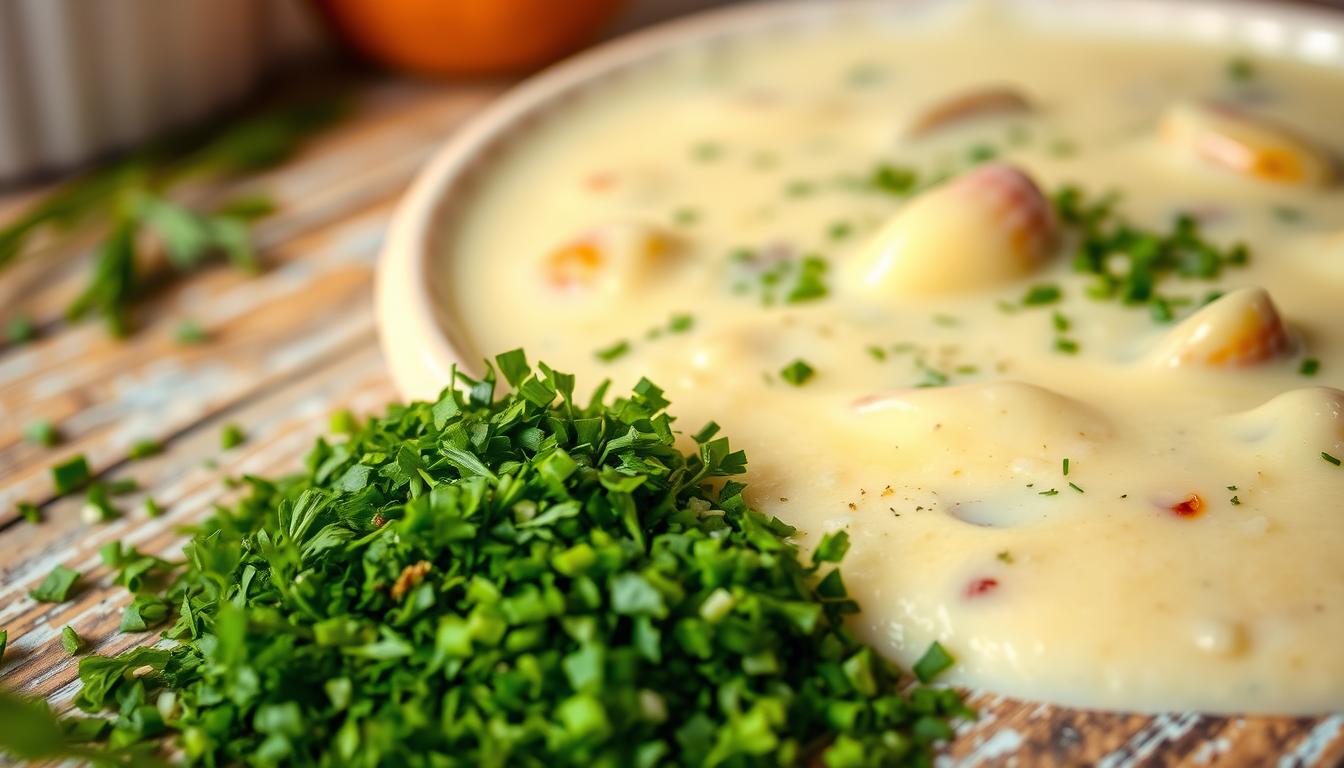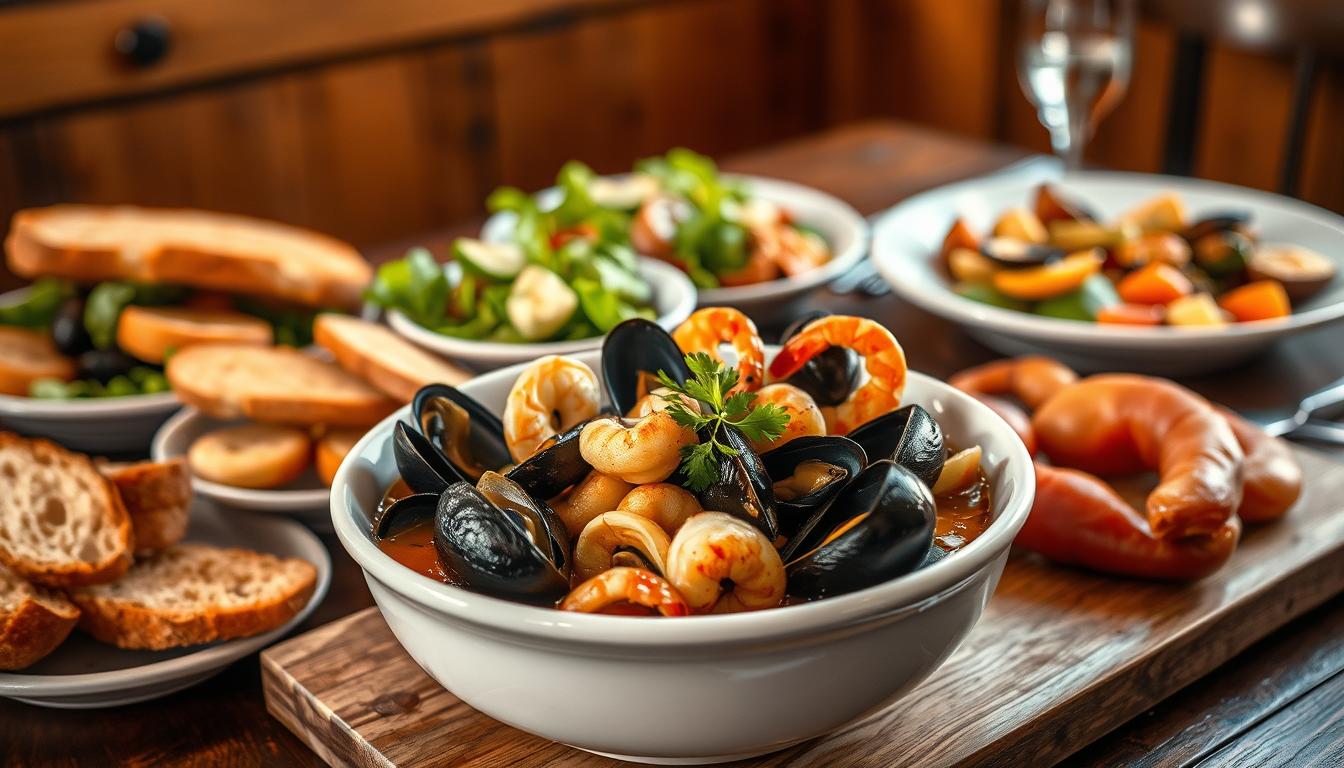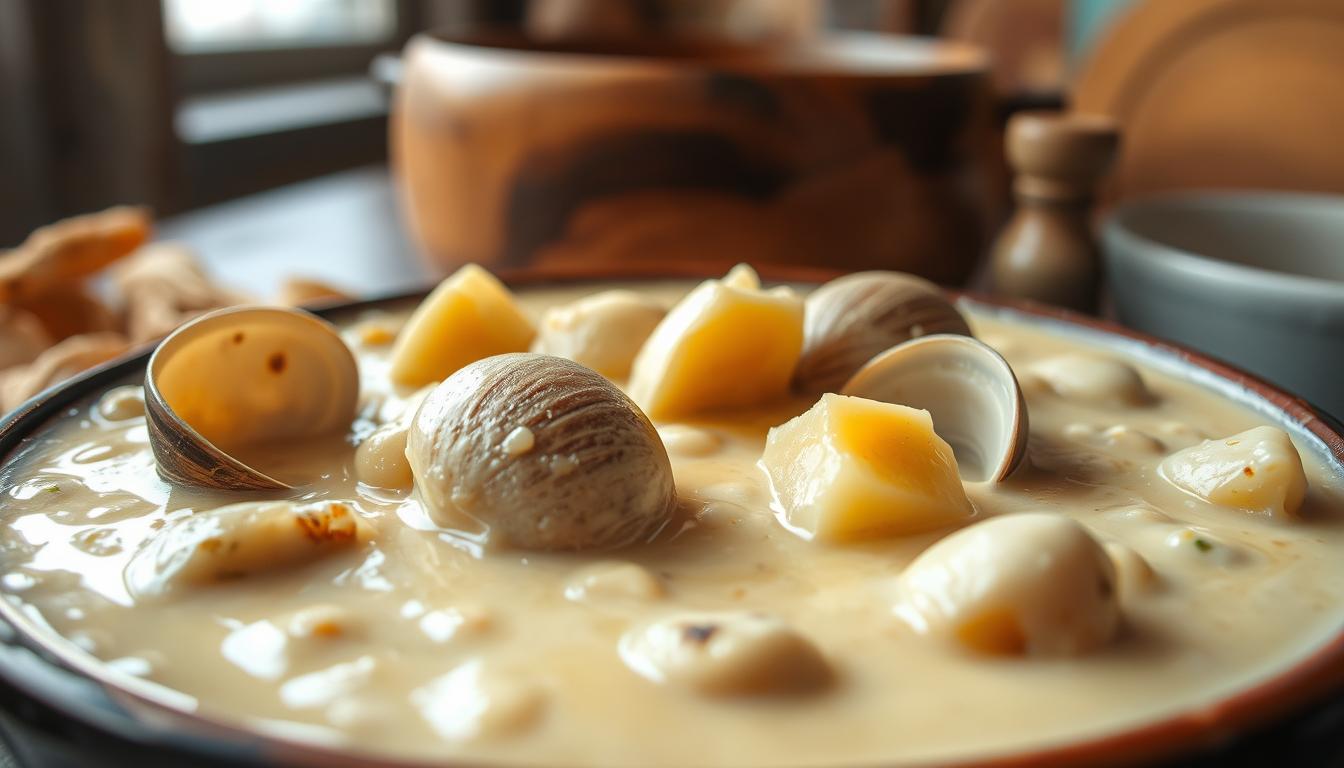This creamy clam chowder recipe is a New England tradition. It mixes flaky clams, velvety potatoes, and savory broth for a coastal comfort. Since the 1700s, it’s been loved for its hearty flavors and simple ingredients.
Fresh clams add zinc and protein, while potatoes bring fiber and texture. This makes every spoonful nourishing and nostalgic.
Picture a crisp autumn afternoon in a small coastal town. The scent of butter and onions fills the air. Your grandmother’s recipe, passed down through generations, is beside you. As the clams steam open, their briny essence fills the air.
This moment captures the essence of the chowder. It’s a dish that connects heritage and home-cooked warmth.
Key Takeaways
- Rooted in New England fishing traditions, this chowder uses fresh clams and classic ingredients.
- Clams provide protein and minerals, while potatoes add fiber and heartiness.
- The recipe balances creamy texture with savory flavors for a timeless taste.
- Simple steps make this dish approachable for home cooks of any skill level.
- Small tweaks let you adapt the classic while honoring its roots.
Introduction to the Classic New England Clam Chowder Recipe
Dive into the world of recette de chaudrée de palourdes, a dish filled with history and taste. It comes from the New England coast, where it’s been loved for centuries. Its creamy broth and salty clams show the area’s seafaring past, mixing simplicity with coastal beauty.
Recipe Origin and Tradition
This chowder started in fishing towns that depended on the sea. It used local clams and simple ingredients like potatoes and bacon. Later, cream was added, making it unique among other chowders. Each spoonful shares tales of resourcefulness and pride in New England’s food culture.
Health Benefits of Fresh Ingredients
- Clams are full of zinc and protein, boosting immunity and muscle health.
- Potatoes bring fiber and vitamins for a balanced diet.
- Herbs like thyme and bay leaves add flavor without too much salt.
Enjoy tradition and health with this recipe. The recette de chaudrée de palourdes is more than food; it’s a link to history and healthy eating.
Discover the History and Tradition Behind the Chowder
Learn about chaudrée de palourdes de la nouvelle-angleterre, a dish with deep roots. It began in 18th-century New England fishing towns. It was a simple stew for sailors back then.
Over time, it grew into the beloved dish we know today. It combines French, English, and Indigenous flavors.
“The best chowder tells a story of the sea and the hands that prepared it.” – Early New England fishermen’s proverb
Old recipes used local items like butter, potatoes, and hardtack. Today, it’s a source of pride for the region. Here are some historical highlights:
- It started in colonial ports like Boston and Newport
- The first written recipe was in 1832
- It was made in iron pots over open fires
Every bite of chaudrée de palourdes de la nouvelle-angleterre links you to sailors and cooks of the past. Today, chefs argue over the “right” ingredients. Bacon or certain clam types are at the center of the debate. Now you see why making it true to its roots is important.
Let’s explore how to keep this tradition alive in your cooking.
Exploring the Authentic New England Flavors
The heart of chaudrée de palourdes maison is in mixing tradition with careful technique. Let’s explore the steps that make this dish a true coastal classic.
Fresh Clam Selection
Choosing the right clams is key to a great chowder. Here’s what to look for:
- Live littlenecks with tightly closed shells
- No sour or fishy odors
- Clams that rattle when shaken (sign of closed shells)
Creamy Consistency Insights
A smooth base comes from slow simmering. Mix whole milk and heavy cream equally, whisking constantly to prevent separation. Add a bit of thyme and bay leaf for extra flavor.
This approach keeps the clams’ natural sweetness while adding depth. Strain the broth through cheesecloth for a silky texture.
Every spoonful of chaudrée de palourdes maison tells a story of patience and precision. Follow these steps, and you’ll enjoy a dish that reflects the ocean’s richness.
Ingredients Breakdown: Fresh Clams and More
Every part of your chaudrée de palourdes crémeuse adds to its delicious taste and health benefits. Let’s look at what makes this chowder a beloved New England dish:
- Fresh clams: The main attraction, packed with omega-3s and protein. Pick plump, tightly closed shells for the best taste.
- Potatoes: They add a sweet flavor and a thick texture, balancing the salty clam taste.
- Onions & celery: Cooked until soft, they create a rich base that makes the soup more complex.
- Heavy cream: Key for the creamy texture in your chaudrée de palourdes crémeuse, adding richness without being too much.
- Bay leaves and thyme: These herbs bring a gentle warmth, while paprika adds a soft smokiness.
Using top-notch ingredients like Duxbury Bay littlenecks or Prince Edward Island potatoes makes a big difference. Always choose clams that are sustainably caught to help protect our oceans. Knowing how each ingredient works together helps you make a dish that’s both traditional and healthy.
The Secret to a Rich and Creamy Base
The best clam chowder starts with a special base. It’s smooth and just right, making simple ingredients taste amazing. Let’s learn how to make it happen.
Using Fresh Cream
Quality cream is key. Here’s how to use it:
- Choose fresh cream for a natural thickness—no stabilizers needed.
- Add it slowly while simmering to meld flavors without curdling.
- Try brands like Organic Valley or Horizon for a creamy texture that shines.
Balancing Flavors Perfectly
Flavors must work together. Follow these steps:
- Salt gradually, tasting as you go. Over-salting masks the clams’ brininess.
- Use a bay leaf and thyme sprigs for earthy depth without overpowering.
- Let the chowder rest 10 minutes post-cook to let flavors meld fully.
Master these steps, and your pot becomes the best clam chowder you’ve ever made. The best clam chowder isn’t just a recipe—it’s a journey of taste and skill.
Techniques for Preparing Tender Clams
Keeping clams tender is crucial for great chowder. The chaudrée de palourdes rapide method makes prep easy while keeping flavors vibrant. Follow these steps for a dish that honors tradition without fuss.
- Rinse clams under cold water, scrubbing shells with a brush to remove sand.
- Steam clams in a pot with ½ inch water, cover tightly. Cook 5-7 minutes until shells open—discard any that stay closed.
- Remove clams promptly to prevent overcooking. Use tongs to transfer to a bowl.
Timing and gentle heat are key. Overcooking makes clams tough, while quick steaming preserves their sweetness. The chaudrée de palourdes rapide method is perfect for quick meals. Strain the steaming liquid and add it to the chowder for more flavor.
Always use fresh, live clams for the best texture. These steps ensure every bite of your chowder showcases the clams’ natural brininess. Perfectly cooked clams make both classic and modern chowder dishes shine.
Step-by-Step Cooking Process
Learning the recette classique de chaudrée de palourdes involves following traditional steps. This guide will help you make a creamy, savory dish. It celebrates New England’s culinary heritage.
Preparation Steps for Success
- Heat butter in a large pot over medium heat. Sauté diced onions and celery until they’re translucent.
- Add diced potatoes and bacon bits. Cook until the edges start to soften, stirring now and then.
- Pour in clam juice and heavy cream. Let it simmer gently.
- Stir in fresh clams and parsley. Cook until the clams open—throw away any that don’t.
- Season with paprika and cracked black pepper to taste.
Insider Cooking Tips
- Always use live, fresh clams for the best flavor and safety.
- Simmer on low heat to keep the cream base together.
- Add clams last to keep them tender.
- Taste and adjust the seasoning before serving.
By following these steps, you can make the recette classique de chaudrée de palourdes with confidence. Each step adds to the flavor, making every bite a delight.
Clam Chowder: A Classic New England Recipe
Discover the timeless allure of authentique chaudrée de palourdes, a dish rooted in New England’s seafaring heritage. This chowder isn’t just a meal—it’s a celebration of fresh seafood and creamy comfort. Whether you’re savoring it in a coastal diner or crafting it at home, its soul lies in respecting tradition while embracing innovation.
Embracing Tradition
Classic authentique chaudrée de palourdes relies on simple, high-quality ingredients. Use butter for sautéing, potato for heartiness, and fresh clams for that briny kick. Follow time-honored steps like simmering clams gently to preserve their delicate flavor. This approach ensures every spoonful honors generations of culinary history.
Modern Twists and Adjustments
Experiment without losing authenticity! Try these updates:
- Add a dash of smoked paprika for depth
- Swap heavy cream with coconut milk for a dairy-free option
- Top with crispy bacon bits or chives
“Tradition is a foundation, not a cage,” says coastal chef Sarah Marlowe. “Let your taste guide you while keeping clams front and center.”
Whether you stick to the original or tweak it, the key is balance. Let the clams shine while letting your creativity flow. Every variation keeps the spirit of New England alive—authentique chaudrée de palourdes at its best.
Flavor Enhancements: Herbs and Seasonings
Enhance your chaudrée de palourdes classique with the perfect herbs and spices. These add-ons bring out the clams’ freshness while keeping their natural taste. Here’s how to mix flavors:
- Thyme: A few sprigs add earthy warmth to the broth.
- Bay Leaves: Simmer one leaf per pot for a subtle, traditional aroma.
- Paprika: A pinch of smoked paprika deepens richness without heat.
- Parsley: Chopped fresh parsley brightens the dish as a final garnish.

“In classic French chowders, herbs like thyme and bay were sacred—today, they’re still the foundation for balanced flavor.”
Begin by toasting garlic and onions with dried thyme before adding liquid. Remove bay leaves before serving to avoid bitterness. Start with half a teaspoon of paprika to avoid overpowering the clams. Fresh dill or chives are great for a lighter taste.
Experiment but always let the clams be the star. A dash of white pepper adds saltiness without the metallic taste of black pepper. Adjust the seasonings slowly, trusting your taste to make a chowder that’s both classic and uniquely yours.
Mastering the Texture: Avoiding a Watery Chowder
Making a velvety New England clam chowder is all about avoiding a watery texture. This recette de chaudrée facile uses traditional methods and fresh ingredients. It makes sure every spoonful is rich and satisfying. Here’s how to get that perfect creaminess:
Achieving the Perfect Creaminess
- Start with heavy cream—it has a lot of fat, so it doesn’t separate easily.
- Cook clams briefly to keep their juices in and not release too much liquid.
- Thicken with a roux: melt butter, mix in flour, then slowly add milk or broth to make a smooth sauce.
- Stir in cold butter at the end to add richness without curdling.
Optimizing Cooking Time
- Simmer ingredients low and slow—fast boiling can thin the broth and lose flavors.
- Let the chowder rest for 10 minutes before serving. This helps flavors meld and the texture become velvety.
- Check if clams are done early; overcooking can release too much moisture.
Small changes can make a big difference in this recette de chaudrée facile. By balancing patience with technique, you get a hearty, spoonable chowder every time.
Serving Suggestions and Garnish Ideas
When you serve your recette traditionnelle de chaudrée de palourdes, make it special. This dish is great for cold weather or cozy nights. Add these simple touches to make it stand out:
- Herbs: Sprinkle chopped parsley or dill for a fresh finish.
- Texture contrasts: Top with crispy bacon bits or croutons for crunch.
- Zesty accents: Garnish with a wedge of lemon for a bright tang.
- Traditional touches: Dust with a dash of paprika or parsley flakes.
Serve it hot in rustic bread bowls for a fun experience. Enjoy with buttered dinner rolls or oyster crackers. For a special touch, add a swirl of extra cream on top. The dish’s golden color and aroma will make everyone excited to try it.
Pairing Your Chowder with Sides and Wine
Make your New England clam chowder even better with the right pairings. This dish, also known as chaudrée de fruits de mer, is best with flavors that balance its rich taste. Whether you’re eating at home or hosting guests, the right sides and drinks are key.

A great pairing respects the chowder’s boldness without overwhelming it.
Side Dish Pairings
Choose sides that contrast or complement the chowder’s creaminess:
- Crisp buttered cornbread for texture contrast
- Roasted seasonal vegetables like carrots or Brussels sprouts
- Light green salads with citrus vinaigrette
Wine Recommendations and More
Pair your bowl with beverages that highlight its seafood essence:
- White wine: Oaked Chardonnay or dry Riesling
- Sparkling options: Crisp Prosecco or dry Champagne
- Non-alcoholic: Sparkling water with a citrus twist
For a modern twist, add a sprinkle of Old Bay seasoning to sides. Let the chowder’s natural flavors shine while supporting pairings enhance the meal’s harmony.
Troubleshooting Common Clam Chowder Issues
Mastering the recette de chaudrée classique means solving unexpected twists in the kitchen. Even with quality ingredients, texture or taste issues can arise. Let’s address these challenges head-on for a perfect bowl every time.
Fixing Overly Thick or Thin Chowder
Texture problems? Try these quick fixes:
- Too Thick: Stir in ¼ cup clam broth or milk gradually.
- Too Thin: Simmer uncovered to reduce liquid, or add a slurry of flour mixed with water.
Balancing Flavors Effectively
Off-kilter taste? Adjust with these steps:
- Add a dash of hot sauce to cut through richness.
- Season with lemon juice for brightness if flavors feel flat.
- Blend in a spoon of butter to mellow sharpness.
Every tweak brings you closer to the creamy, savory harmony of authentic New England recette de chaudrée classique. Practice patience—you’ve got this!
Tips for a Quick and Easy Clam Chowder
Want to enjoy the meilleure recette de chaudrée de palourdes fast? This recipe is a mix of old and new. Begin by preparing your ingredients the night before. This will save you time in the kitchen.
- Use pre-shucked clams: Choose pre-cleaned clams in jars for quick prep.
- Batch cooking: Cook broth and veggies first. Then add clams last to keep them tender.
- Smart substitutions: Use half-and-half instead of heavy cream for a quicker thickening.
For a quick fix, add a store-bought bisque base as your roux. Always strain liquids to avoid grit. Serve with crusty bread to enjoy every bit.
Quality doesn’t mean slow. These tips help you make a delicious chowder in under an hour. And you’ll still get that classic New England taste.
Conclusion
The classic New England clam chowder, or soupe de chaudrée de palourdes, is a mix of tradition and taste. It comes from coastal fishing communities. This dish uses fresh clams, potatoes, and herbs for a hearty meal.
It’s packed with nutrients like vitamin C and omega-3s. Whether you stick to the chaudrée de palourdes traditionnelle way or add your own twist, every bite is a tribute to its history. You can also make it your own by changing the flavors.
Start by picking plump clams, then simmer the creamy base, and work on the texture. If you run into problems, there are tips to help. Pairing ideas can also make it even better.
This recipe is more than just a meal. It connects you to New England’s culinary heart. Share it with your family or try new spices. But always keep the main ingredients fresh.
Now, it’s time to get cooking! Chop those onions and let your kitchen fill with the smell of the coast. Your bowl is waiting!

